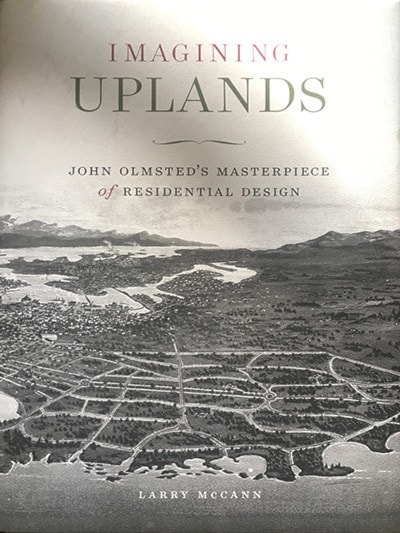Strolling the Uplands’ gently winding tree-lined streets, taking in the ocean views across to Mt. Baker and enjoying the varied architecture, it’s difficult to imagine it as anything else.
Especially the Hudson’s Bay Company farm it was when landscape architect John Olmsted first set eyes on it in April 1907.
But imagine Olmsted did, and from that emerged one of North America’s premier residential developments and a legacy created here at home and in cities across Canada and the U.S.
Based in Brookline, a suburb of Boston, Olmsted’s designs include the Seattle and Portland park systems, plus work in Winnipeg and Calgary’s Mt. Royal neighbourhood.
Back at the turn of the 20th century, “he was persuaded – reluctantly – to come to Victoria,” says Larry McCann, author of a beautiful new hardcover book, Imagining Uplands.
“As soon as he saw Uplands Farm, that was it. He was just taken with it. It reminded him of an English deer park.”
Imagining Uplands, John Olmsted’s Masterpiece of Residential Design “recounts John Olmsted’s efforts to create an ideal and trend-setting subdivision.”
Published by Brighton Press and designed by Lara Minja, the book takes readers from the conception to the planning to the creation of the unique “residential park.”
Winnipeg-based developer William Gardner bought the property from the Hudson’s Bay Company – it was among the some 5,000 acres HBC owned in the region at the time – and engaged Olmsted for his unique vision that blended both the artistic and practical. The two men, while years apart in age, shared a similar vision for the property. When Gardner sold the Uplands site to the Franco-Canadian Corporation in 1911, it was agreed that Olmsted’s design remain intact.
Olmsted asks at the time, “(With) the picturesque landscape of the Uplands, the basis of the design is to make the best possible use of the more important features of the local scenery for a human purpose in which the element of beauty is recognized to be essential, for will not all who go there to live take much anxious thought not only as to the appropriateness and beauty of their improvements but as to their harmony with the natural beauties surrounding them?”
Buried in Olmsted’s thousands of letters to his wife, held at Harvard University, was his reflection that “this is the best he’d done.”
Throughout Imagining Uplands, McCann weaves the personal stories of the people involved in the project with details from the recently incorporated District of Oak Bay, Hudson’s Bay Company, the CPR and others.
“The development of the Uplands is quite complex and is ongoing over time,” McCann says.
The story has long intrigued the University of Victoria professor emeritus of geography, who enjoyed a 40-year teaching career specializing in urban and Canadian studies.
“This one has been in the works for a long, long time,” McCann says. “I was always interested in the Uplands; the landscape is beautiful.”
At the same time, “I wouldn’t have written it if it weren’t for the involvement of John Olmsted,” says McCann. “He intrigued me as a person whose story needed telling.”
The Oak Bay High alumnus is well-versed in the neighbourhood, earning his undergraduate degree from the University of Victoria before doing graduate work at the University of Alberta.
While writing the book, McCann also led university students in preparing a building history map of Oak Bay which is available on the municipal website at oakbay.ca.
What makes the Uplands special?
“It’s the way the streets and the lots are designed to harmonize with the land,” McCann explains. “Even in 1907, John believed that you had to save the big oaks.”
The impact of the Uplands development was felt not only locally, but much farther afield.
With its gently meandering roads and carefully sited properties, it was the first large Canadian subdivision to break from the traditional grid pattern.
“It’s the melding of the physical environment and the careful design.”
Following in its wake were areas such as the prestigious British Properties in West Vancouver and others in Spokane, San Francisco and Los Angeles.
Here at home, implications ranged from sewer and water – privately held by the development companies as Oak Bay was too small to undertake such improvements at the time – to design standards that reached far beyond the bounds of the Uplands itself.
For example, Oak Bay’s first major zoning bylaw in the 1930s served to support the Uplands’ upper middle class ideals and avoid the smaller houses seen elsewhere in the Victoria region, McCann notes.
When the Lansdowne slope was developed after the Second World War, it was designed to mimic the curving street design of the neighbouring Uplands.
“The Uplands has influenced many facets of Oak Bay’s development, such as lot sizes, water provision, park development and zoning,” McCann says.
Bringing McCann’s words and research to life is Minja’s inspired design, augmented by artwork by Ryan Price.
“It was a most enjoyable experience working with Lara Minja. She’s just so talented,” McCann says.
Imagining the Uplands can be purchased at local bookstores, including Ivy’s Bookshop in Oak Bay village, Bolen Books and the University of Victoria bookstore.
